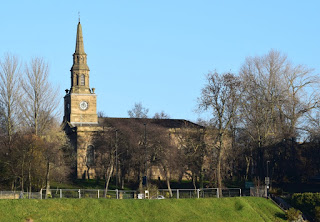St. Ann's Church in City Road, Newcastle, was consecrated in 1768. There has been a church on this site since medieval times. The present church was largely built with stone from the City Walls. The churchyard is among the last within the city to be closed for burials and is the resting place of many who died in the last great cholera epidemic.
A great history of the church is available at St. Ann's website here.
7th July 2022


Taken from across the Tyne in Gateshead.
2nd January 2022


1st World War Memorial.



Grave of Joseph Crawhall.
Joseph Crawhall (1793-1853) ropemaker and artist. Born in Allendale. Arrived in Newcastle aged 16 with his elder brother Thomas. He began a ropemaking apprenticeship at the wooden shipyard at St. Peter's. In 1812 he took over St Ann's ropery opposite St. Ann's Church.
Joseph was a fine painter, caricaturalist, lithographer, etcher and wood engraver. He was a friend of wood engraver Thomas Bewick. Joseph was Mayor of Newcastle in 1849 and a magistrate. He died at Stagshaw House near Corbridge aged 59.
Source: Sitelines.





10th February 2021











15th December 2020

30th September 2019
14th May 2009
29th July 2008
22nd July 2008
r.jpg)
r.jpg)
r.jpg)
r.jpg)
r.jpg)
17th February 2007
13th July 2006
7th June 2006
1968
Photo courtesy of Newcastle Libraries
1968
Photo courtesy of The JR James Archive team
1912
Photo courtesy of Newcastle Libraries
More Information:
- St. Ann's Church Website
- Co-Curate: Church of St. Ann, City Road
- Historic England: Church of St. Ann
- Sitelines: Church of St. Ann
- Sitelines: Church of St. Ann, grave of Thomas Coulthard
- Sitelines: Breamish Street, St. Ann's Parish Hall
See my other photos around St Ann's Church:





.jpg)
.jpg)
.jpg)
.jpg)
.jpg)

.jpg)
.jpg)
.jpg)




recently visited this church in search of the war memorial in it's grounds, lovely old church with lovely helpful people.
ReplyDeleteYes I remember st Ann's Church used to play there as a kid.
ReplyDeleteI lived in reade Street number 26 used to play with a kid called Tony mckenna he lived in the next street I left in 1968 when the houses were condemned